Mammals
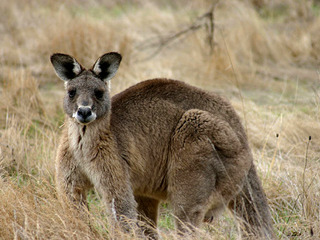 |
Bennet KangarooEastern grey kangaroos can be found on the eastern coastlines of Australia, all of Queensland with the exception of western Cape York, South Wales, and parts of Tasmania, most notably the north eastern portion. There is great sexual dimorphism in size, with the males ranging from twice to three times the mass of an average female. Females usually weigh up to about 40 kg, while males can weigh over twice as much, up to 90 kg. Eastern grey kangaroos are grazers and eat a wide variety of foliage ranging from grasses to forbs (broad-leaved herbs besides grass that grow on plains and meadows). The main choice of food, however, is grass, which grows on the plains that these kangaroos usually inhabit. In captivity, eastern greys may also feed upon fruits, although this is not part of the usual diet in the wild. |
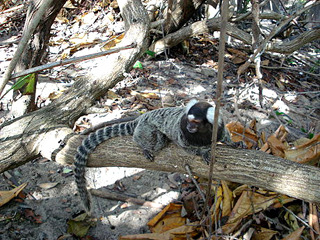 |
Marmoset MonkeyThe buffy-tufted-ear marmoset belongs to a family of Callitrichidae. They have striking ear tufts which, as its common name suggests, are coloured pale buff or whitish. The sides of the head are densely furred and black, while, the crown is white. The rest of the body is dark blackish brown, with the exception of the tail, which is grizzled yellowish-grey and marked with distinct black bands. Buffy-tufted-ear marmoset groups may comprise either a single breeding pair, or a single male with multiple female breeding partners and their offspring. Most Callithrix aurita give birth to two young during spring each year. Gestation period is about 170 days. Callithrix aurita is endemic to the Atlantic forest of south-east Brazil. Callithrix aurita is primarily insectivorous. Their diet includes ants, termites, larvae, caterpillars, and large-winged insects. |
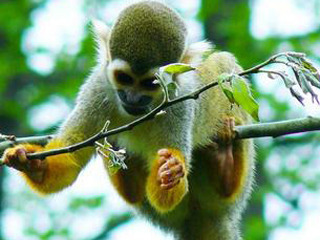 |
Squirrel MonkeyThe squirrel monkeys are the New World monkeys of the genus Saimiri. Squirrel monkeys live in the tropical forests of Central and South America in the canopy layer. Most species have para- or allopatric ranges in the Amazon, while S. oerstedii is found disjunctly in Costa Rica and Panama. Squirrel monkey fur is short and close, colored olive at the shoulders and yellowish orange on its back and extremities. Their throat and the ears are white and their mouths are black. The upper part of their head is hairy. Squirrel monkeys grow to 25 to 35 cm, plus a 35 to 42 cm tail. They weigh 750 to 1100g. They live together in multi-male/multi-female groups with up to 500 members. Squirrel monkeys are omnivores, eating primarily fruits and insects. Occasionally they also eat nuts, buds, eggs and small vertebrates. Females give birth to young during the rainy season, after a 150- to 170-day gestation. They live to about 15 years old in the wild, about 20 years in captivity. |
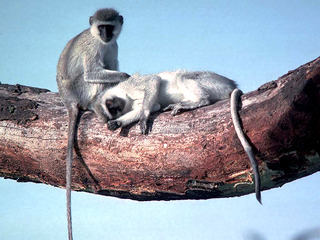 |
Vervet MonkeyVervet monkeys (Chlorocebus aethiops) are found from Senegal to Ethiopia and south to South Africa. Vervet monkey (chlorocebus aethiops) is usually around 400 to 600 mm in length (head and body), with tales about 300 to 500 mm. weights typically range between 3 and 5 kg. Males are larger than females. The faces of vervet monkeys are usually sooty black. A defining characteristic of this species is the greenish color of the upper parts of the face. Females typically have few mates in their lifetime, whereas some males have numerous mates. Little is known about the reproductive habits of Chlorocebus aethiops; however, like most primates, they are cyclically receptive. Females take a strong interest in raising their young. Within the social groups, other females often share this task with the mother. Chlorocebus aethiops is omnivorous but with a heavy emphasis on fruit. Their diets often Include insects, vegetable matter, and at times, small mammals and birds. |
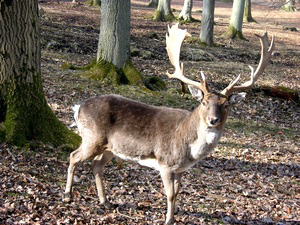 |
Fallow Deer (Dama Dama)Fallow deer or Dama Dama have a natural range in southern European regions, Asia Minor, along the Mediterranean Sea, and possibly in northern Africa and Ethiopia. They have been widely introduced to 38 countries in North and South America, Europe, South Africa, Australia, New Zealand, and Fiji. The average body mass of adult males is 67 kg, and females 44 kg. The head and body length is 1.3 to 1.75 meters, tail length is 150 to 230 mm, and the shoulder height of males is generally 0.9 to 1.0 meters with the females slightly smaller. Fallow deer forage on a variety of vegetation, usually grasses, mast, and browse. Other items in their diet may include dwarf shrubs, leaves, shoots, and bark. |
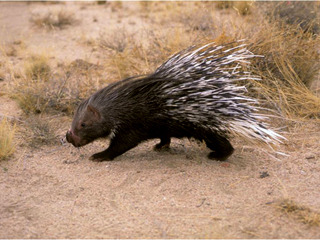 |
Indian Porcupine (Hystrix Indica)The Indian porcupine (Hystrix indica) is found throughout southeast and central Asia and in parts of the Middle East. The Indian porcupine is highly adaptable to multiple environments. Although they usually favor rocky hill sides, the species can also be found in tropical and temperate scrublands, grasslands, and forests. They are also found throughout the Himalayan mountains, reaching up to elevations of 2400 meters. It weighs 11 to 18 kg. On average, the Indian porcupine's head and body measure 70-90cm in length, with the tail adding an additional 8-10cm.Its hair is highly modified to form multiple layers of spines. Each quill is brown or black in color, with alternating bands of white. Spines vary in length, measuring 15 to 30 cm. Gestation for the species, on average, lasts 240 days.Brood size varies, ranging from 2 to 4 offspring per year. Young are born with their eyes open, and the body is covered by short soft quills. The Indian porcupine is usually monogamous, with both parents being found in the burrow with their offspring throughout the year. The main food source for the Indian porcupine is vegetable material of all kinds, including fruits, grains, and roots. |
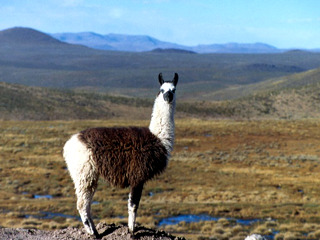 |
LamaLama (Llama glama) is a mammal that belongs in the family of camelids. It has height of 1,20 m. and weight 100 kg. Its hair is long, brown, white or black, depending on the species. The head of lama is short and narrow, with prominent mouth, in order to graze, since it is vegetarian. After a 10 month gestation, it gives birth to only one lama, which in one and a half year will create its own family. It lives in the highlands of Peru and Bolivia. Generally prefers cold climate and do not go down in sunny and hot plains. Males are used as means of transportation and they can cover 30 km per day carrying weight above 60 kilos. Also, they are generally compliable animals and they have good balance, they can climb difficult paths. The females are not used for transportation , but for the production of wool. |
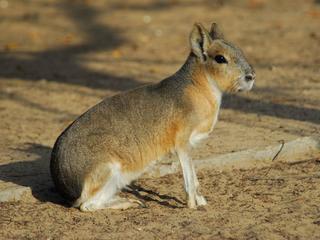 |
Maramara In keeping with its strange appearance, the Patagonian mara displays behavioural traits that are very unusual among the rodents. Active during the day, this species spends long periods basking in the sun. It remains vigilant for predators, however, and when threatened, may escape by galloping or stotting, a high-speed form of locomotion involving rapid bounces using all four limbs at once. Surprisingly, this diminutive species can reach speeds of 45 kilometres per hour over distances in excess of one kilometre. The Patagonian mara consumes a variety of vegetation, usually feeding in grass or shrubland during the day and sheltering in an abandoned burrow of another species, or amongst dense vegetation at night. After a gestation period of 90 days, the female gives birth to a litter, usually of two young, close to the entrance of a burrow . Patagonian mara are grayish-brown above and white below. The hindquarters have a large white patch. The stiff, dense hair is very fine in texture. The Patagonian mara is endemic to Argentina. |
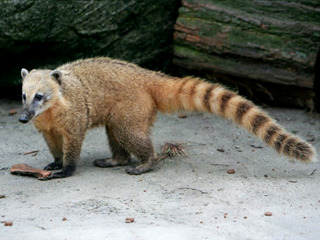 |
Nasua Nasua CoatisNasua nasua is found in tropical regions of South America, from Columbia and Venezuela to Uruguay, northern parts of Argentina, and into Ecuador. On the eastern and western slopes of the Andes Mountains they are found up to 2500 meters. Coati upper parts are dark brown, grayThe underparts are white. The head is narrow with the nose slightly turned upward and elongated, and is very flexible, allowing coaties to search out food under leaf litter and overturned debris. The muzzle is brown with pale spots above, below, and behind the eye. The ears are small and fringed with white on the inside rims. The long tails of coatis are used for balance, and are black to brown with yellow rings. Coatis have thick, dull fur. The young are not as darkly colored as adults. Adults measure 41 to 67 cm from head to the base of the tail, with the tail adding an additional 32 to 69 cm to their length. These animals are about 30 cm tall at the shoulder, and weigh between 3 and 6 kg. Mating occurs from October through March, and young are born between April and June. |
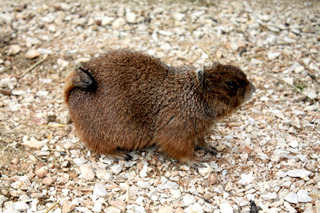 |
Praire DogPrairie dogs (Cynomys) are burrowing rodents native to the grasslands of North America. They are a type of ground squirrel. On average, these stout-bodied rodents will grow to be between 30–40 centimetres long, including the short tail and weigh between 0.5–1.5 kilograms. They eat all sorts of vegetables and fruits. The highly social prairie dogs live in large colonies. Families usually consist of 1 male and 2-4 females living in a strict social hierarchy. Prairie dogs are social animals and often make social visits with each other, and greet each other with a sort of kiss. Their tunnel systems can descend vertically as much as 5 metres (16 ft), and can extend laterally as much as 30 metres (98 ft).Using its dichromatic color vision, it can detect predators from a far distance and then alert other prairie dogs to the danger with a special, high-pitched call. The prairie dog is chiefly herbivorous, though it eats some insects. They have 1-6 pups yearly, which are born blind and furless and need about 30 days of close nurturing from their mother. |
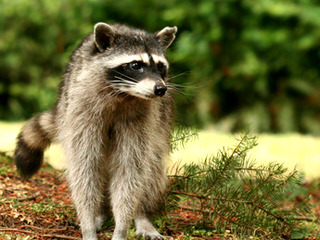 |
RaccoonThe raccoon is a medium-sized mammal native to North America. As a result of escapes and deliberate introductions in the mid-20th century, raccoons are now also distributed across the European mainland, the Caucasus region and Japan. It has body length of 41 to 72 cm (16.1–28.0 in) and weight of 3.6 to 9.0 kg (7.9–19.8 lb). Two of its most distinctive features are its extremely dexterous front paws and its facial mask. Raccoons are omnivorous and usually nocturnal; their diet consists of about 40% invertebrates, 33% plant foods and 27% vertebrates. After a gestation period of about 65 days, two to five young are born in spring. Although captive raccoons have been known to live over 20 years, their average life expectancy in the wild is only 1.8 to 3.1 years. |
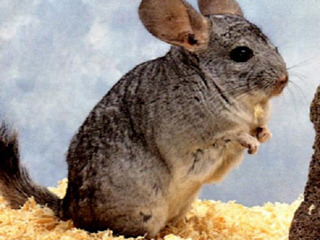 |
ChinchillaChinchillas are crepuscular rodents, slightly larger than ground squirrels, native to the Andes mountains in South America. They belong to the family Chinchillidae. In their native habitat, chinchillas live in burrows or crevices in rocks. Chinchillas have a variety of defensive tactics including spraying urine and releasing fur if bitten. In the wild, chinchillas have been observed eating plants, fruits, seeds, and small insects, though this diet could irritate the digestive system of a domestic chinchilla whose diet should be primarily hay-based. In nature, chinchillas live in social groups that resemble colonies but are properly called herds. Chinchillas can breed any time of the year. Their gestation period is 111 days, longer than most rodents. Due to this long pregnancy, chinchillas are born fully furred and with eyes open. Litters are usually small in number, predominately twins. |
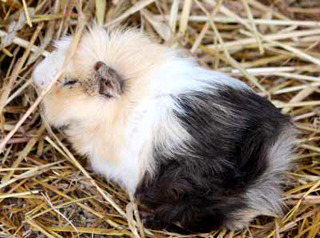 |
Ginea PigThe guinea pig (Cavia porcellus), also commonly called the Cavy, is a species of rodent belonging to the family Caviidae and the genus Cavia. Despite their common name, these animals are not pigs, nor do they come from Guinea. They originated in the Andes, and studies based on biochemistry and hybridization suggest they are domesticated descendants of a closely related species of cavy such as Cavia aperea, C. fulgida, or C. tschudii, and therefore do not exist naturally in the wild. Guinea pigs are large for rodents, weighing between 700 and 1200 g (1.5–2.5 pounds), and measuring between 20 and 25 cm (8–10 inches) in length. They typically live an average of four to five years, but may live as long as eight years.The guinea pig is able to breed year-round, with birth peaks usually coming in the spring; as many as five litters can be produced per year.[9] The gestation period lasts from 59–72 days, with an average of 63–68 days. Newborn pups are well-developed with hair, teeth, claws, and partial eyesight. |
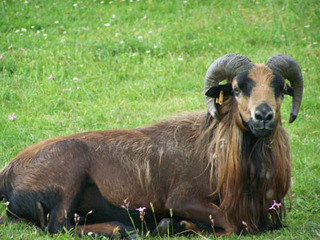 |
Cameroun GoatA pygmy goat is a small breed of domestic goat. Although they produce a very large amount of milk for their size, and can be eaten, pygmy goats are not typically used for milk or meat, unlike larger dairy and meat goat breeds. Pygmy goats tend to be more robust and breed more continually throughout the year than either dairy or meat goats. They are also sometimes kept as pets in urban or suburban backyards, depending on local regulation of livestock ownership. Like all goats, pygmy goats have stomachs with four compartments: the rumen, the reticulum, the omasum, and the abomasum. As browsers, goats are similar to deer and enjoy variety in their diet, including woody plants. The pygmy goat is quite hardy and can adapt to virtually all climates. Females, called does or nannies, weigh 23 to 34 kg (51 to 75 lb) and males, called bucks or billies, are weigh 27 to 39 kg (60 to 86 lb). Wither height ranges from 16 to 23 in (41 to 58 cm). Pygmy goats originated in the Cameroon Valley of West Africa. They were imported into the United States from European zoos in the 1950s for use in zoos as well as research animals. |





